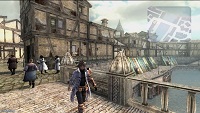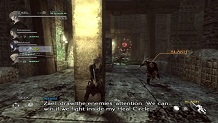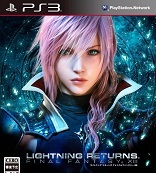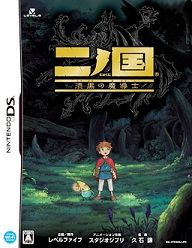The Last Story
Wii
Reviewed: 10/20/2012
The first thing you should know about The Last Story, Mistwalker’s latest RPG, is that it has an immense amount of stuff to do. If reviewing this hadn’t been a priority, I’d still be running around Lazulis. Given the talent behind the development, it comes as no surprise that the game is as impressive as it is.
The game’s town singular has a fantastic setup. The town’s very large and filled with thoroughfares, side alleys, and dead ends. There’s the requisite Arena in which the player can earn extra cash and experience. There’s tons of NPCs milling about and several have small fetch quests to fill; others open up sidequests. There are enough NPC model variations to fill the town rather well. Sadly, the lack of defining features make it hard to differentiate between NPCs who offer quests and those who do not. There’s no quest log to keep track of the favors NPCs ask. The quest log has become an integral part of RPGs – I was taken aback, though a little refreshed; to not have it. It added to the exploration of the game. Combined with the random, stat-boosting items you find throughout the city in the game’s search mode (a first-person viewing mode also used in many cutscenes); just running around doing stuff became kinda fun. Especially since almost all of the dungeons can be replayed with enemies scaled to the player’s level and the increased chance of finding rare items.
There’s a simple weapon and armor upgrade system in the game that requires items found around the city and in dungeons. Leveling up weapons enhances the weapons with new skills. Upgrading armor can also yield new skills, but each level adds some cosmetic change to the armor. Swords and armor change the outward appearance of a character, which is awesome. What’s more awesome is that each piece of the armor can be turned on and off to create a custom set for the character. And then there’s the ability to color the armor from a variety of hues. So yes, those are the Power Rangers walking around Lazulis with their dazzling leader Sakura Pink. Sadly, this was a good idea until the game’s sidequest armor came into play and rather large sexual organ was commanding our band of mercenaries. More on that later.
The battle system in The Last Story is pretty fun. It combines simple commands with three separate types of gameplay fairly easily into one system. The first and most prevalent focus on these systems is the real-time combat.
First off, do yourself a favor and swap out the controls in the options to save you some hassle. The default control scheme has the movement and attack functions on the same analog stick for simplicity. Moving towards an enemy will turn into an auto-attack once the player is close enough. As long as the analog stick is tilted towards the enemy, the character will keep attacking. It’s a wonderful system when fighting against bosses; large, single creatures; or when hunting down groups of weak monsters. But it’s absolutely frustrating when surrounded by enemies, especially if a small window of escape presents itself. Attempting to escape through a gap in a formation may prove impossible when the controls constantly attack the enemy nearest to the player. Thankfully, these controls can be switched on the fly. The dodge function is terrible and of little use. The weak dodge function is one of the very few combat complaints in The Last Story, outside of the occasional enemy-laden gangbangs.
 |
| Zael pimps about town in Rinoa’s digs. |
Allies aren’t controlled directly by the player unless the story calls for it, though the player can issue commands in line with the strategic aspect of combat. There are skill attacks as well, which primarily diffuse magic circles. Magic circles, which grant buffs and debuffs, pop up on the field when any mage casts a spell or an object on the battlefield is used. Diffusing these circles can cause damage and grants other status effects. Using and diffusing circles is one of the core strategies in the game.
The dungeon design in The Last Story is quite good, and large spaces often have multiple ways to attack enemies. This brings out the third part of combat; stealth. It is entirely possible to flank or surprise enemies with the lead character. Stealth uses a combination of cover mechanics and not running around like a jackass.
The main character’s special power needs its own mention. When the player activates Zael’s plot hand, most of the enemies aggro on him immediately. Zael’s power is also the only way to revive from being knocked out in the game. In an interesting inverse of many JRPGs, your characters can typically only take a couple of hits before they go down, while your average foes can take a bit more damage at similar levels.
If the immense amount of things to do in The Last Story is the first thing to keep players coming back for more, combat will definitely be the second. This is good, because if the story is what you are playing this game for…well…prepare to be disappointed on an intense level.
Saying “plot-wise” might be an oxymoron. You’ve played The Last Story before. Its plot is almost entirely predictable, dull, and most times, plot twists are just used to pad the length of the game. It’s a shame, because the first third of the game sets up a decent story. There’s at least one point where I threw my controller down in disgust due to plot stupidity. The fallout from the setback ruined a fair bit of characterization for the lead cast member as well. When random events fail to drive the plot forward, Zael’s blind stupidity is used to advance the game. Zael’s romantic interest Calista’s shares some blame as well, as her characterization is an excellent example of how to take a potentially strong female character and then turn her into a damn accessory. Additionally, there’s little reason why Zael and Calista’s care for each other so much, despite it being a major subplot in the game.
The Last Story is also a huge fan of 11th-hour uperpowers and Deus ex Machina to the max. Your party tells you to leave them behind while they deal with enemies everyone together would be hard-pressed to kill? They will catch up just in time to defeat that barrier around whatever boss Zael is fighting. This happens often enough the player can set his watch by it.
On the plus side, there’s tons of characterization not involving Zael and loads of little voiced events throughout the game. The amount of talking going on between party members is positively absurd. You will get a feel that your party really becomes a family over the course of the game. The characterization would be a shining point of the series if Zael would have had a benefit from it. Lowell, Yurick and Mirania grow through the course of the game, though Mirania’s is very subtle and hilarious. Syrenne shows some predictable growth as well. Dagran’s growth is very predictable, yet satisfying. Even if the game all but drops him from most of the finale.
 |
| “That’s right, Zael. You lure him away and wrestle with him while I set up the video.” |
Graphically, The Last Story is good. Faces have lots of detail to them, and there are neat touches all over the place that show the development team really put some heart into it. However, the game suffers from the “Real is Brown” mentality, and not a lot of color is reflected throughout the architecture or world. Dungeons and the excellent designs of them may be overlooked do to color choices. This seems to be an intentional design choice as the world of The Last Story is dying, and Lazulis is one of the few vestiges of environmental stability on the planet. Still, judging by the moderate amount of colors players can add to their armor it seems the dev team could have done a little better. Unfortunately, the game does chug a bit; especially in battle-heavy scenes or latter-game custscenes. CGI scenes look good overall, but the way the Wii handles them suggests that the system was not the best fit for this game. It would have been better off on a more powerful console, if only to give the battles and cutscenes and added touch of smoothness.
Outside of the title theme and some of the battle music at the end of the game, The Last Story‘s music is almost instantly forgettable. Sound effects come across well, but most importantly voices are loud and clear. The dub was done over in the UK and it is fantastic. In fact, the UK localization team did a great job with very few complaints. The UK dub gives the game a definite flavor. It really enhances the fantasy background for Yanks like me. Beer is beer, and the game is more than a little randy. While it’s easy to hate on Zael, he does give himself an awkward boner courtesy of Syrenne’s teasing. Despite absolutely infuriating plot twists, all of the dialogue is written very well. Syrenne and Lowell’s lines are particularly outstanding, while Mirania’s voice… I just can’t picture anyone else playing that role now. The localisation team just did one of the best jobs ever. My only complaint is the amount of names changed for the English version – but at the same time, the original names just wouldn’t seem to roll of the British tongue so well.
The Last Story has a fantastic New Game Plus mode. Everything from the previous game is kept for the second playthrough. Additionally, level caps on weapons and armor are lifted so they can be enhanced even further. Boss enemies jump up in levels dramatically and are a challenge. Additionally, summon circles — a way for the game to catch up players who were low on experience — now spawn harder enemies.



The Last Story‘s online multiplayer is divided between two parts: Deathmatch and Co-Op. Deathmatch features Team Deathmatch and Free For All, where all players have essentially the same stats and run around the field trying to shiv one another. It’s not very fun, and the gameplay is like a stripped down version of the game’s core gameplay. But players can win unique dyes and different leveling items to use in the main game.
Co-Op is a lot more fun. The same combat from Deathmatch is present, but dying carries a higher penalty. And you can only be revived if another player comes over to you. Each Co-Op fight is in an arena with a powered-up version of one of the game’s bosses. The first time a player competes and successfully completes a match against each boss, they get a bonus weapon and other items are awarded afterwards. The player’s weapons and armors from the main game grant bonuses in Co-Op. Sadly, finding a Co-Op match is much harder than finding people for Deathmatch.
The Last Story is a really fun game whose plot should only be given attention when you run out of sidequests. The weak protagonist, and quite frankly idiotic twists are truly frustrating. I understand the game is about emotions and how powerful they are, but the game did little but reinforce the negative storytelling trappings of JRPGs. This is truly a shame in light of Mistwalker’s earlier work Lost Odyssey, which is everything the JRPG genre — Final Fantasy in particular — should have grown into, years ago. As a result, it’s the strength of The Last Story‘s battle system, clear and spoken dialogue, and excellent localization upon which any recommendation lies.
-Russ Ritchey
| Score Breakdown | ||
| Overall Very Good Out of 10 See our Review Criteria |
Gameplay | Excellent |
| Story | Bad | |
| Graphics | Very Good | |
| Sound/Music | Very Good | |
| Replay Value | Average | |
| The Verdict: Very Good | ||









